Ofcom 2017 Study – Average UK Home Broadband Speeds Rise to 36.2Mbps
Ofcom’s annual study of fixed line home broadband ISP speeds across the United Kingdom has revealed that the average Internet download rate is now 36.2Mbps (up from 28.9Mbps last year), with uploads hitting 4.3Mbps (up from 3.7Mbps). But there’s a widening gap between rural and urban areas.
The data for this study was gathered during November 2016 via specially modified routers from SamKnows, which were installed in around 2,023 homes across the country. Of course the limited sample size remains a hindrance and as a result the regulator’s study is only useful for reflecting the performance of those who subscribe to the largest ISPs (i.e. BT, Sky Broadband, EE, PlusNet, TalkTalk and Virgin Media).
On top of that we should point out that Ofcom rebalanced the study last year so that their sample data was “less dominated by high-speed packages“, which means that the regulator’s pre-2015 results from similar studies may not make for a perfect comparison over time.
Advertisement
Average Download Speeds (% Improvement vs Prior Report)
* April 2017 = 36.2Mbps (+25.26%)
* March 2016 = 28.9Mbps (+26.75%)
* February 2015 = 22.8Mbps (+21.93%)
* October 2014 = 18.7Mbps (+5.06%)
* April 2014 = 17.8Mbps (+21.09%)
Firstly, it’s important to put today’s latest results into some context. At present fixed line “superfast broadband” (24Mbps or faster) networks, most of which use some form of Cable (DOCSIS) or FTTC (VDSL2) technology, are available to around 92% of the United Kingdom, although a little over half of the country still subscribe to the much slower and less reliable ADSL (up to 8-20Mbps) based pure copper line services.
You can see the difference in real-world speeds by connection technology and time of day below. This is useful data because the Advertising Standards Authority (ASA) is widely expected to require that ISPs start promoting average speeds instead of ‘up to’ rates (top 10% of fastest connections), although they’ve yet to confirm this. Using this approach an ‘up to’ 76Mbps FTTC package might instead promote an average of c.60Mbps.
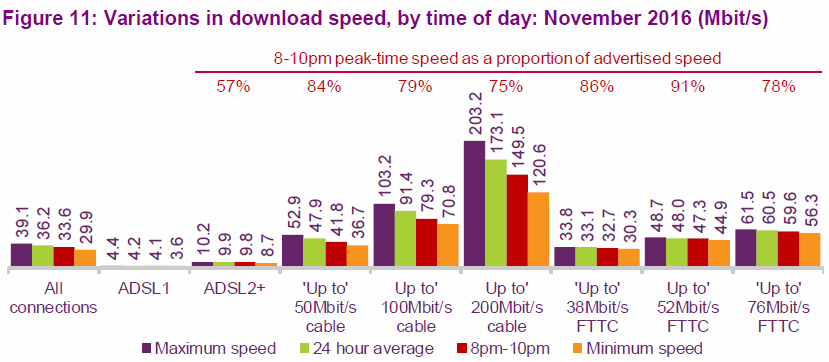
In other words, it’s crucial not to equate speedtest based studies like this to reflect the availability of faster connections as the two are far from being in perfect sync. Similarly not everybody out there can afford, is aware of or even feels the need to upgrade to a modern “superfast” connection, even though such a service might well be available to them.
Advertisement
On the other hand there are some areas where the availability of superfast connectivity is still a significant problem, such as in many rural areas (mostly reflects the last 10% of UK premises). In those locations the existence of slower connections is much more pronounced in the data.
Ofcom’s analysis shows that the average download speed in rural areas of the UK was 12.2Mbps in November 2016, compared to 40Mbps in urban areas. Take note that the table below confusingly appears to use different weights and so the results won’t be quite in line if you try to make a UK average from the nations combined.
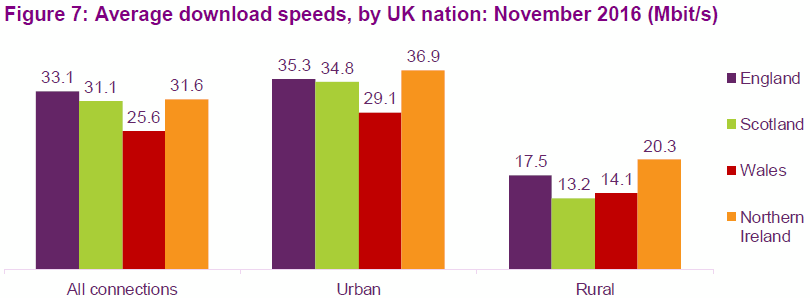
At this point we should add that the Government’s Broadband Delivery UK programme is working to expand the reach of “superfast” capable broadband services to 95% of the country by 2017/18 and there’s an expectation that this could reach 97% by 2020. On top of that the planned 10Mbps Universal Service Obligation (USO) may also improve the performance for those in the final 2-3%.
Advertisement
Most of the work to close the current “superfast” availability gap (between 92% coverage today and 97% in 2020) is taking place as we speak, although it’s worth pointing out that many urban areas are also starting to benefit from a new generation of “ultrafast broadband” (Ofcom defines this as 300Mbps+, while others prefer 100Mbps+).
For example, Virgin Media’s EuroDOCSIS 3 based hybrid-fibre coax network has already made 300Mbps capable and FTTP connections available to around half of the UK and they look set to cover around 65% by 2019. Similarly Openreach (BT) are deploying ‘up to’ 330Mbps G.fast technology to 10 million UK premises by 2020 and this should reach “most of the UK” by 2025 (including their FTTP commitments). Both of those deployments are largely targeted at urban areas (i.e. the low hanging fruit), thus the urban vs rural gap may continue to grow.
Performance by Technology and ISP
Elsewhere it’s no surprise to find that the performance split by connection technology hasn’t changed much since the last report, with Virgin Media’s still superior cable network continuing to do well and older style ADSL2+ services looking increasingly rubbish.
At this point we note the results from a related Ofcom survey, which found that Virgin Media delivered the highest level of consumer satisfaction with broadband speeds (91%) and that compares with 83% for Sky Broadband, 80% for BT and just 71% for TalkTalk. However this is hardly a surprise given that Virgin’s HFC DOCSIS cable network is superior to the ADSL and FTTC dominated Openreach platform used by the others.
The following table highlights the context for this result by contrasting the advertised (headline) service speeds of each connection / package type by the average of what subscribers actually received. It’s worth pointing out that both FTTC and ADSL based connections are very susceptible to signal degradation over distance and poor quality home wiring, which makes it harder for many people to get the best speeds.
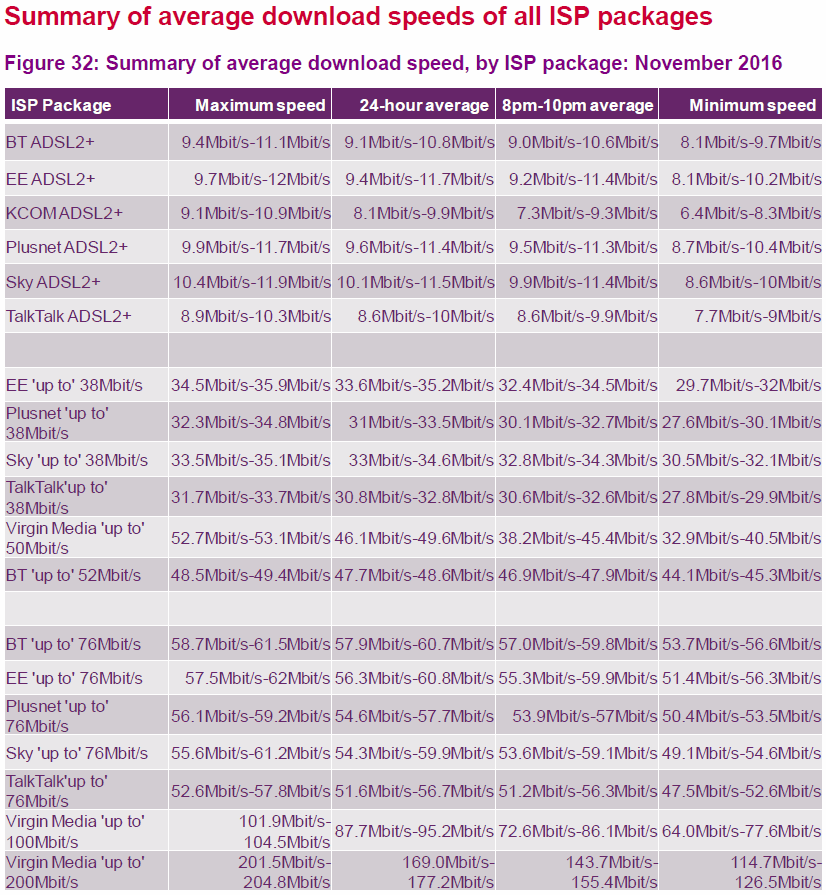
Mind you the above table only reflects the mass market technologies, which are largely dominated by ADSL2+, Openreach’s 40-80Mbps Fibre-to-the-Cabinet (FTTC) and Virgin Media’s 300Mbps capable Cable network. Sadly the small sample size means that we don’t get to see any results from superior FTTP/H based connections.
However it’s clear that there are some big variations, particularly on FTTC services and at the top ‘up to’ 76Mbps package level where the real-world averages struggle to get near to the advertised speeds. Mind you even Virgin Media’s 200Mbps service struggles a bit but we doubt too many people will moan when the average is still around 169-177Mbps!
Latency
It’s good to see that this report has reintroduced Latency into the study, which is a crucial measure of the time (delay in milliseconds [1000ms = 1 second]) that it takes for a single packet of data to travel from your computer to a remote server and then back again (ping).
A lower score (shortest time) is always best for latency and this measure is especially important for fans of online multiplayer games, where a low ping gives you smoother and more accurate gameplay.
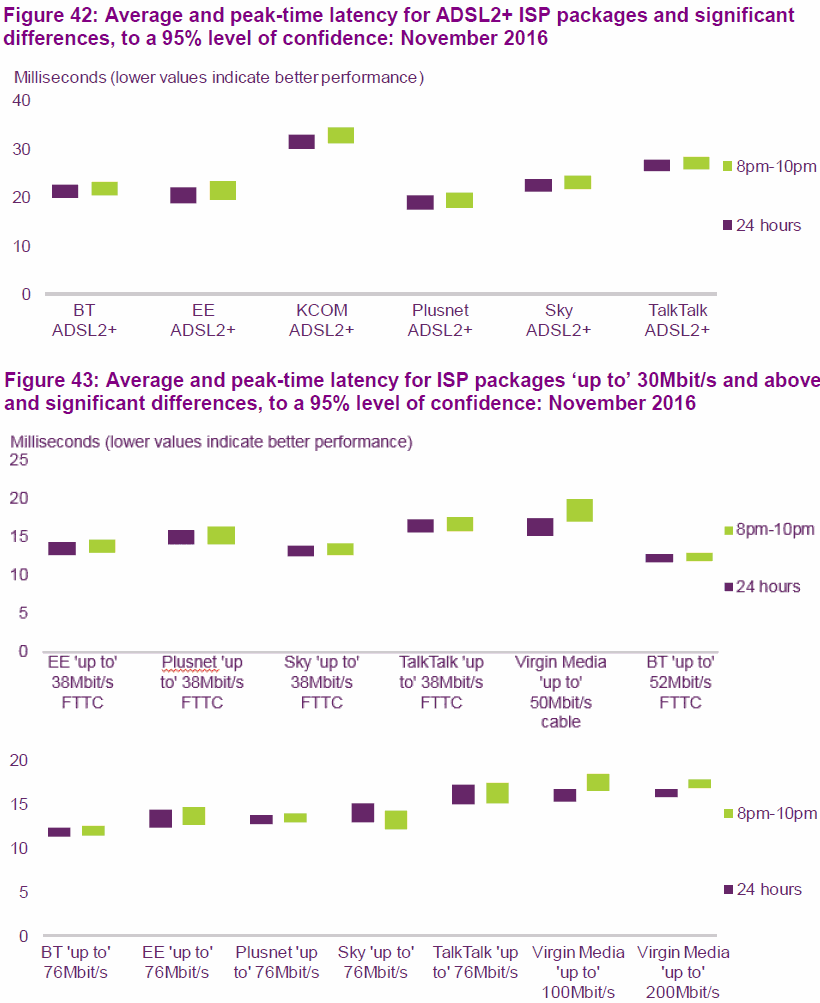
Generally speaking there’s not a lot of difference between the ISPs and everybody should be fairly happy with the latency performance, even ADSL lines manage to deliver 30ms or less and that’s fine for fast paced gaming. However there’s clearly some benefit from adopting one of the more modern “superfast” services, which shave 5-15ms off the latency times.
Just remember that latency is also affected by other aspects too, such as Internet content services / servers and your own network setup etc. Finally, we note that Ofcom also examined the related measure of Packet Loss (i.e. how much data goes missing during transmission, which the connection must then automatically correct).
During normal operation most of the ISPs tested delivered packet loss of around 0% to 0.2%, which is fine. However during peak times (8-10pm) packet loss could spike to nearly 0.8% but this isn’t really high enough to cause much of a concern and most people will never notice its impact.
Resolving Speed Complaints
Readers should take note of Ofcom’s Voluntary Broadband Speeds Code of Practice (note: a separate version exists for small business users), which broadly requires member ISPs to provide reliable estimates of connection performance during the order process and to also help resolve related problems when they arise.
On top of that the code requires ISPs to give new customers a Minimum Guaranteed Access Line Speed (MGALS) upon request, which reflects the access line speeds achieved by the slowest 10% of the provider’s broadband subscribers.
Crucially, if the ISP cannot resolve your problem and the performance has fallen below the MGALS level then the code allows you to leave your contract penalty free and switch to another provider, although this won’t necessarily resolve the underlying problem (especially if it’s related to Openreach’s infrastructure and you swap to another Openreach based ISP).
However Ofcom does say that they are “seeking to update the code” so that speed estimates reflect the impact of contention, and to ensure that customers have better information about their right to exit. The regulator plans to consult on an updated code in summer 2017.
Ofcom Fixed Home Broadband Speeds Report 2017
https://www.ofcom.org.uk/../November-2016-Technical-report.pdf
Mark is a professional technology writer, IT consultant and computer engineer from Dorset (England), he also founded ISPreview in 1999 and enjoys analysing the latest telecoms and broadband developments. Find me on X (Twitter), Mastodon, Facebook, BlueSky, Threads.net and Linkedin.
« Ofcom UK Report Compares Big Broadband and Mobile ISPs by Service Quality




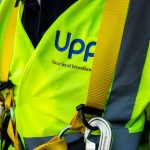

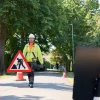

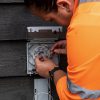








































Comments are closed